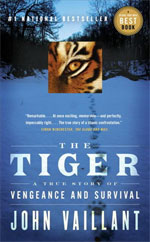
Man disdains nature at his ultimate peril, individually and collectively. John Vaillant drives this home with elegant and unforgettable ferocity in The Tiger, his enthralling account of the hunt for a man-eating tiger in in a harsh, remote area of Russia’s Far East in the late 1990s.
The Tiger is a potent amalgam of different genres and subject matter, each one of which could stand on its own as an engrossing read. Vaillant has forged an unusual, suspenseful action thriller/murder mystery, pitting the intimidating but not unsympathetic presence of a powerful predator against first one man with whom he has specific grievances, and then against a growing team of trackers and investigators looking to halt the predator’s deadly rampage. Subtitling The Tiger “a true story of vengeance and survival”, Vaillant has commented in interviews that the uncanny ability of the tiger to single out specific people for its revenge – chiefly an unemployed logger turned poacher who has inadvertently stolen food from and injured the tiger – adds a “Stephen King” aspect to the story that makes it even more menacing. Coupled with detailed crime scene analysis and forensic procedural elements as the investigation and hunt commences, led by game warden and expert tracker Yuri Trush, The Tiger is a breathtaking true crime read unto itself.
The tale is immensely deepened, however, because Vaillant thoughtfully incorporates into it other investigations that transform the central tragedy into a touchstone for much more, symbolic of problems, challenges, but also hopeful opportunities on numerous levels. The Tiger is filled with vibrant character sketches of individuals striving to survive physically, emotionally and as a community and culture in an isolated area of the world alternately exploited and ignored by Russia, China and other international forces and influences. Vaillant also offers up a reverential National Geographic-calibre examination of a stunningly unique world ecosystem. That examination is stimulating and educational without being monotonously encyclopedic or pedantic. Finally, Vaillant melds it all into a environmental paean that is pointedly cautionary and can be applied universally, all without sanctimony.
The Tiger achieves many fine balances in its interplay of different types of storytelling. The reader will grieve for individuals, a community and a way of life that, while demanding and unforgiving, is still beautiful and stoically pastoral. At the same time, the reader will also cheer for the awesome (in the truest, purest sense of awe), magnificent tiger, who is also fiercely adapting and trying to make a life for itself in an exotic land encroached upon by waves of change triggered by political conflicts, technological pressures, economic demands, societal upheaval and more.
Having managed to grasp and skilfully weave so many thematic threads, Vaillant reminds us that the strength of memorable storytelling is fundamental to our human fabric:
For most of our history, we have been occupied with the cracking of codes – from deciphering patterns in the weather, the water, the land, and the stars, to parsing the nuanced behaviours of friend and foe, predator and prey. Furthermore, we are compelled to share our discoveries in the form of stories. Much is made of the fact that ours is the only species that does this, that the essence of who and what we understand ourselves to be was first borne orally and aurally: from mouth to ear to memory. This is so, but before we learned to tell stories, we learned to read them. In other words, we learned to track. The first letter of the first word of the first recorded story was written – “printed” – not by us, but by an animal. These signs and symbols left in mud, sand, leaves and snow represent proto-alphabets. Often smeared, fragmented, and confused by weather, time, and other animals, these cryptograms were life-and-death exercises in abstract thinking. This skill, the reading of tracks in order to procure food, or identify the presence of a dangerous animal, may in fact be “the oldest profession.”
This rousing tale affects us so profoundly both because it is so richly layered, but also because it is so elemental.
See/hear also:
John Vaillant reads from The Tiger
The Tiger, by John Vaillant (author video)
My reviews of other Canada Reads 2012 finalists:

Pingback: Prisoner of Tehran, by Marina Nemat | bookgaga
Pingback: Inside of a Dog, by Alexandra Horowitz | bookgaga